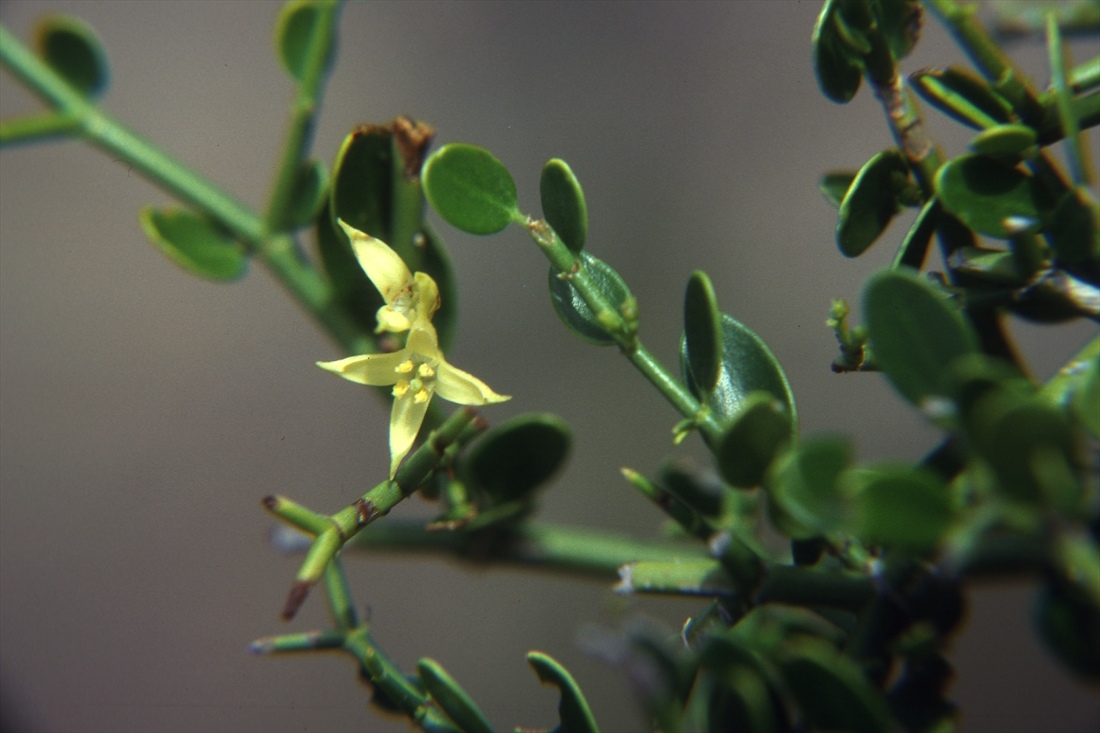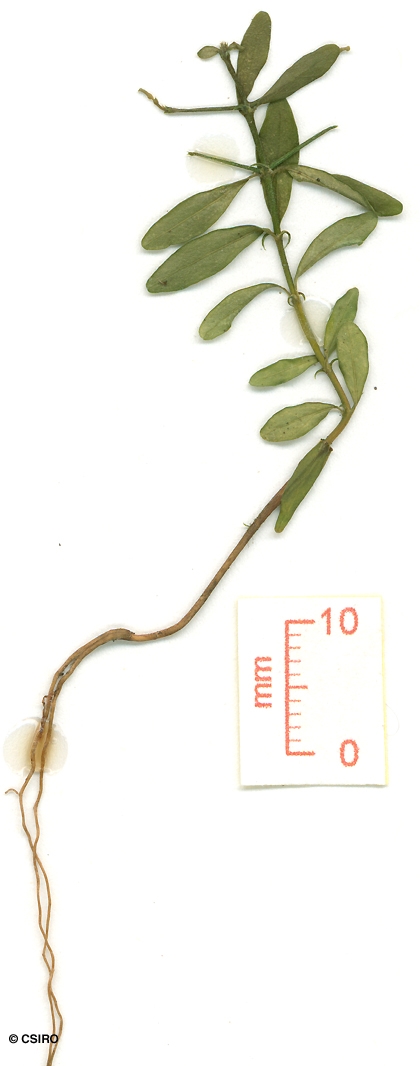Australian Tropical Rainforest Plants - Online edition
Everistia vacciniifolia (F.Muell.) S.T.Reynolds & R.J.F.Hend. var. vacciniifolia






Reynolds, S.T. & Henderson, R.J.F. (1999), Vanguerieae A.Rich ex Dum. (Rubiaceae) in Australia, 1. Everistia S.T.Reynolds & R.J.F.Hend. Austrobaileya 5(2): 356, Fig. 1A-E
Small-leaved Coffee; Small Leaved Canthium; Canthium, Small Leaved
Flowers and fruits as a shrub, erect to 2-3(-7) m tall or prostrate. Bark grey or creamy grey, smooth. Branching divaricate or forked, densely leafy or with a few scattered leaves and spinose or sometimes leafless. Young stems sparsely hairy, stems becoming hairless.
Leaf opposite, simple. Most leaves held in one plane. Stipules interpetiolar, ovate or broadly triangular with a median spur-like projection, 0.7-1.1 mm long. Petiole 0.5-2 mm long. Leaf blades small, about 0.35-1 cm long, 0.35-0.8 cm wide, base cuneate or ± truncate, margins entire, flat or recurved, apex obtuse or retuse. Domatia absent. Leaf surface flat, concave or channelled on the upper surface leathery, hairless or with minute spreading hairs, lateral veins obscure.
Inflorescences axillary, 1-3 flowered in umbels. Flowers bisexual, usually 4-merous. Calyx tubular, to 1 mm long, lobes very short. Corolla 5-9 mm long, tube about 4 mm long, lobes about 3 mm long. Inner surface of the corolla tube clothed in a ring of downward pointing hairs just below the area where the staminal filaments are attached to the corolla, corolla cream or white or yellow with age. Stamens usually 4, exserted; ovary inferior, styles exserted, stigma bilobed.
Cotyledons linear-oblong, about 8-10 x 2-2.5 mm. Cotyledonary stipules triangular, very small and transparent. First pair of true leaves narrowly elliptic and opposite. Stipules horn-like. At the tenth leaf stage: leaf blade narrowly elliptic, about 10-12 x 3 mm, apex ± obtuse, base cuneate or attenuate. Stipules about 1-1.5 mm long, ± subulate, resembling the cataphylls which are quite common on seedlings of this species. Spines often present in leaf axils.
Probably endemic to Australia, occurs in CYP, NEQ and southwards as far as north-eastern New South Wales. Altitudinal range from near sea level to 750 m. Grows in monsoon forest, vine thickets and brigalow scrub.
This species is variable over its distribution across the east coast of Australia and two varieties and two forms are described. The variety that occurs in the region treated by this key Everistia vacciniifolia var. vacciniifolia has had two forms recognised. An attractive shrub with small leaves that should be tried in horticulture. Would be useful for drier areas.
Everistia vacciniifolia forma vacciniifolia has leaves that are flat or slightly concave or deeply grooved along the midrib region on the upper surface, the upper surface is slightly shiny, hairy or hairless and the lateral veins not apparent.
Everistia vacciniifolia forma crassa has leaves that are flat, the upper surface is shiny and hairless and the lateral veins are obscure or not apparent.
A third entity, identified by Reynolds (1999) but not formerly described by her, is included in this description and is found on sandy beach ridges in northern Cape York Peninsula including the Torrres Strait Islands. This profile information and associated coding has been adapted from Cooper & Cooper (2004), Reynolds & Henderson (1999), and Harden et al. (2014).
Canthium vacciniifolium F.Muell., Transactions of the Philosophical Institute of Victoria 3: 47 , (1859), Type: "In barren scrubby localities near the rivers Burdekin, Suttor, McKenzie, Dawson, and Burnett, accompanied by Canthium oleifolium." Lecto: “Suttor River, F. Mueller [MEL 1538572; isolecto: K], Reynolds & Henderson, Austrobaileya 5(2): 356, (1999)





